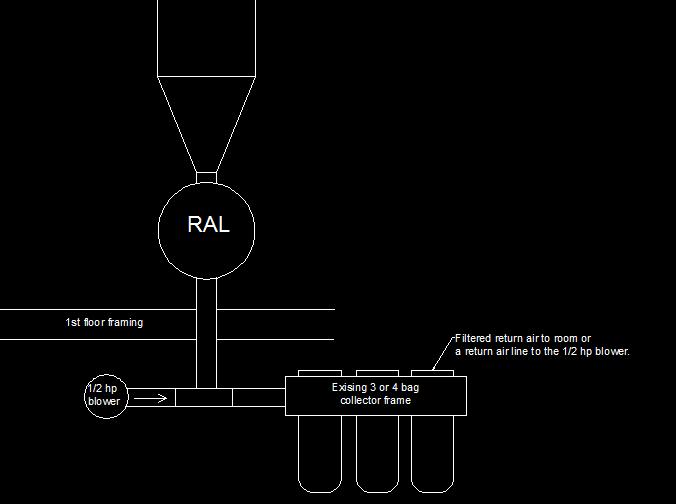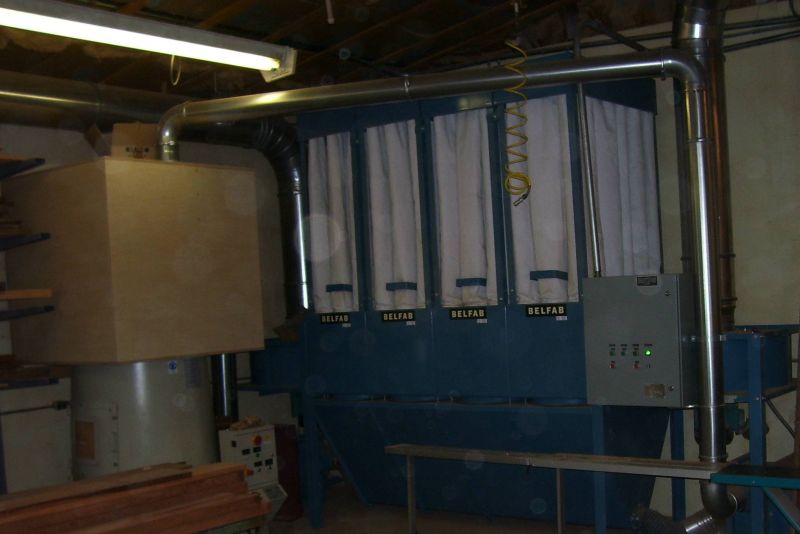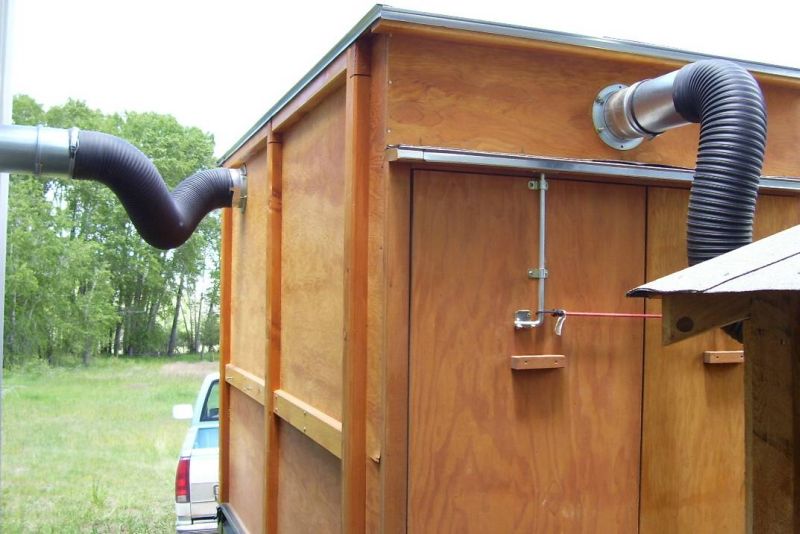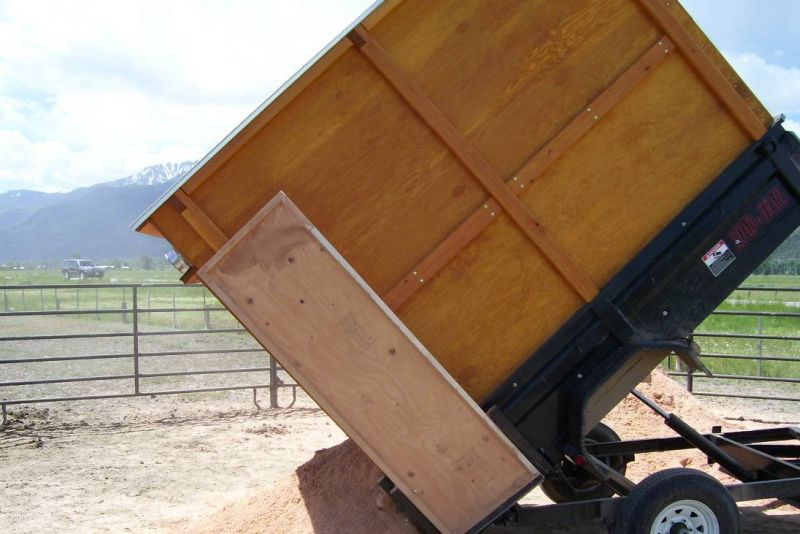Question
I recently installed an Oneida 5hp cyclone system above a rotary air lock. This has replaced our old blower that just blew the shavings into a trailer behind the building. The system is located on the main floor of the shop, and the rotary air lock dumps into the basement below. Right now I just have a 55 gallon bag connected to the outlet pipe on the RAL and the shavings drop directly down into that bag. I have been working with a small1/2 hp blower to develop secondary loop to blow the shavings into a larger container as we obviously have to change out the 55 gallon bag way too often.
What I've come up with is taking an old three or four bag blower system frame and using it without a blower to collect the dust and shavings. This would be the typical 10 to 15 hp Woodtech type units you see with three or four plastic collection bags sitting directly below three or four filter bags that blow up towards the ceiling.
My idea is to just use the plastic collection bags - no large blower or filter bags above. From this point I then have two options after putting a "T" at the bottom of the RAL outlet. Both ideas have the 1/2 hp blower connected to one side of the "T" and the used three or four bag frame and bags on the other. The RAL will dump down into the "T" fitting and the 1/2 hp blower will then push the shavings towards the bag collection assembly.
In the subsequent first option I can block the filter bag holes completely. In the last filter bag hole away from the "T" I can insert a 4" take off ring to return air to the blower. This will create a loop in which air (and any dust or shavings that don't drop down into the bags) will return to the blower and then repeat the cycle.
In the second option I can put very short filter bags (say, 12" high instead of the more normal 4' to 5' high) on the upper return air openings of the frame. This will allow filtered air to return to the room and the blower will just operate from room air instead of air that has cycled through the bag system. Has anyone ever put anything like this together?

Forum Responses
(Dust Collection and Safety Equipment Forum)
From contributor D:
I assume you have the secondary fan to move the shavings some distance from the outlet of the RAL. I think your first option, with the loop of pipe/air back to the secondary fan is ideal since it eliminates the bag filter. I would view the bag filter as the weak link, since if it clogs with filter cake, it prevents/slows exit of air, therefore inflow of air, and the fan will cavitate, and shavings will fill the line. Just be sure the 4" is adequate, as you want no restriction at all in this line - free flowing air is where it's at. The secondary fan will cake with fine dust and require cleaning periodically, since dusty air will be flowing. Be sure the fan itself is non-ferrous to prevent sparking should loose metal be introduced anywhere.
I have used a farm screw auger for moving shavings. Low rpm, 8" diameter, 1/2 hp would move 5 yards in 15 minutes. It has the advantage of not stirring up dust as much as a fan. We currently have an eight yard dumpster under the RAL, semi-sealed into a small room to limit the airborne dust.
On pressure systems, that is where a blower is pushing dust and shavings into a cyclone, there is no need for a rotary air lock. The shavings will just drop out of the bottom of the cyclone and into your collection bin. However, the exhaust will be under some pressure so your collection bin still needs to be fairly tightly sealed or all the air will flow out the bottom of the cyclone instead of into the air filters on the exhaust side of the cyclone. In a vacuum system, where the blower is mounted on top of, or beyond, the cyclone, dust and shavings are being pulled into the cyclone instead of being pushed into it.
In this case there is a negative pressure, or vacuum situation, within the cyclone and the drop pipe at the bottom of the cyclone where the shavings and dust drop out. In this case your collection bin below the cyclone must be tightly sealed or air gets sucked up into the cyclone from the bottom, as well as from the dust and shavings intake pipe. This causes all the dust and shavings to blow through the cyclone and into the filter media.
Most small shop cyclones come with a 30 or 55 gallon barrel that mounts to the drop pipe of the cyclone. This is tightly sealed so no air can get into the cyclone from the bottom. The dust and shavings just drop into it. It is under enough suction so as to lift a cardboard barrel right up off the floor (if connected as typical by flex hose) until a few pounds of shavings fill the barrel. Unfortunately a 30 or 55 gallon barrel is often times not large enough for real world conditions where emptying multiple times a day is too costly.
This is where the rotary air lock comes into play. The air lock replaces the collection barrel on the bottom of the cyclone. If it were turned off when the dust collection system is running then your collection bin is in effect the size of one of the revolving cavities in this sideways revolving door. However, since it rotates automatically whenever the dust collector is on, it dumps each of those little collected piles of shavings into the collection bin below under gravity as the rotary air lock is always sealed by horizontal pairs of revolving pockets - at least theoretically.
I say at least theoretically because when I turned on my rebuilt rotary air lock for the first time I got vacuum leakage through it and it actually tried to suck my plastic collection bag upwards toward the cyclone. I called both Oneida (the cyclone manufacturer) and Donaldson-Torit (the rotary air lock manufacturer) to find out if this was a problem with my rebuild. I was told by both tech depts. that this is absolutely normal and that no rotary air lock creates a perfect seal. It just creates one that is adequate for the process. So, hope I haven't been too long winded here and that the explanation at least makes some degree of sense.
First, the 12" to 8" reducer tended to clog, just not quite enough gravitational force to keep it clear. That is why the final system will have 12" into a 12" T. When the blower was on high it helped to suck the shavings down and into the airstream, but not enough to make it look like it would be problem free.
Second, the 4" blower was surprisingly too powerful. With the blast gate all the way open it just cycled most of the pine shavings around and around, with a small amount dropping down on every cycle. I added a baffle above the bag opening and that helped, but again, not quite there yet.
When I reduced the air flow by closing down the 4" blast gate I still blew the shavings that dropped into the airstream, and they were more likely to drop down into the bag. However, the 12" to 8" reducer was more likely to clog.
So, that sent me in another direction as described in the original post above. The scheme is to use the blower at full blast and blow into a larger cavity. This will reduce the air speed over the bags and the shavings should be more receptive to dropping down into the bags. I liked the idea of the filters because it takes the continued cycling around the blower circuit for light dust and shavings out of the equation. I do understand the issue of clogging though and that is certainly a concern. However, if I end up making a box out of plywood, or can find a used bag rack without the blower, I can easily go from one system to the other. Thanks all of you for your input. Very helpful!
The picture shows the 6” dust transfer pipe going into the 1 yard box above the briquette press. You cannot see the 8” return line to the fan. In summer, or when running the moulder hard, we transfer to a 15 yard dump trailer outside.

Here is the 15 yard dump trailer with 6” inlet at rear and 8” return on side. Everything needs to be fairly airtight. You also need gates on both the inlet and outlet pipes to balance the pressure.

Also, I had started to consider a larger return pipe size. I was thinking a 12" pipe going straight up perhaps 2' out of the far end of the bag frame, and then taking the 4" return out of that. I think that is still a good idea but I'll up upsize the rest of the return line to at least 6", if not 8". I'll still try the small 1/2 hp fan. This is a small system with only the 5hp collector and on the first test run the 1/2 hp fan seemed to be more than enough but we'll see. I can always up size that if need be.
To the original questioner: Did you ever decide anything on processing and burning your sawdust?
The press is a Comafer. It is the lower end of European presses. I would buy a German press if doing it over. The biggest problem is they don’t have service in the US. Weima USA now offers presses and service. Stiles is bringing in a high end mechanical press. They have been used in Europe for many years and fast becoming cost effective here due to energy and waste removal costs.
We had some problems with the Comafer brought on by ourselves and improper installation. The moulder does over-run it in about 20 minutes of steady production. My unit is 7 ˝ HP and will produce 150 lbs of bricks per hour. The bigger machines will keep up with a moulder and a larger silo above the unit would help.
Burning sawdust makes the most sense, but a hefty investment to do it right. It’s common in mid and larger size European shops to see a system with a large silo, grinder for scraps and a boiler fed by an unloader from the silo. The dump trailer is cost effective for us. It costs one hour of time per 15 yards of shavings. We have such a large demand from the local horse people now we are able to charge for dumping.
